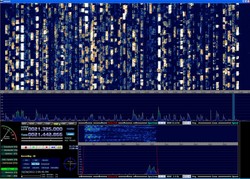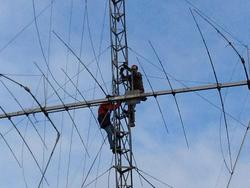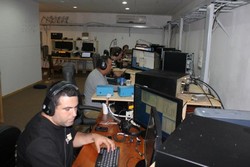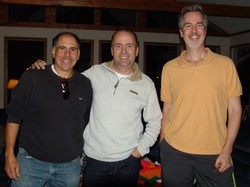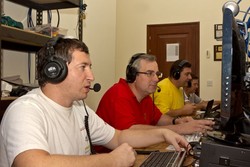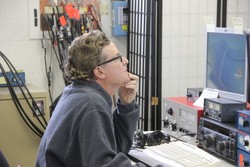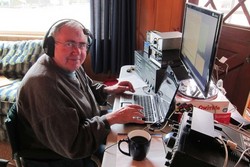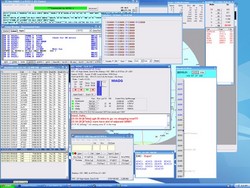 November 7, 2012 Editor: Ward Silver, NØAX | |||||||||
IN THIS ISSUE
NEW HF OPERATORS - THINGS TO DO If you are into the digital modes, try for some RTTY DX in the final Worked All Europe weekend. The special "QTC" rule gives the WAE a special flavor all its own. Sweepstakes resumes on the following weekend by filling up the phone bands. Make sure you have the latest logging software to get full credit for all four of the new VE3 sections! BULLETINS This is a generic bulletin - don't forget to send in your logs! The deadlines for all of the major contests have been made much shorter and with all the big events in November, it is too easy to lose track of things. BUSTED QSOS No particularly notable errors in the previous issue. CONTEST SUMMARY Complete information for all contests follows the Conversation section November 10-11
November 17-18
How many contests are there throughout the year? Well, there are rather a lot! In 2012, the Contest Corral database tracks 440 different contests. The online WA7BNM and SM3CER contest calendars have even more, especially sprint and regional contests in Europe. Of the 440 tracked in Contest Corral, 326 (74%) are HF-only and 35 (8%) only use the VHF+ bands. 73% feature CW - the most popular contest mode by nearly 2-to-1 over Phone (46%) and Digital (37%). Even though there are 22 more contests this year, the proportion of CW:Phone:Digital remains almost exactly the same.
During "our" domestic CW Sweepstakes, you may have heard other stations around the world engaging in their own events, such as the Worked All Germany and the Ukrainian DX Contest. There are two new contests sponsored by the Amateur Radio Society of India that you should also know about: the Himalayan Contest which took place over the Sweepstakes weekend and the VU International DX Contest coming up on Dec 3rd and 4th. While communications between North America and India is over a long polar path, even modest stations can bag a VU QSO by watching for gray line (see "Working the Gray Line" by NA5N) and long-path propagation (Thanks, Prasad VU2PTT) Due to the devastation and power outages throughout the North East resulting from Superstorm Sandy, the NYQP Organizing committee has decided to extend to deadline for log submissions for the New York QSO Party an additional 10 days. Therefore the log submission date will be November 15th at 0000Z. (Thanks, NYQP Committee members Brent KC2QLJ and Paul K2DB) The California QSO Party (CQP) is also extending their deadline for log submission in response to the problems created by Hurricane Sandy. The new deadline is November 10. Electronic logs are strongly encouraged. Paper logs may be mailed to K6SRZ's QRZ.com address. (Thanks, 2012 CQP Chair, Alan K6SRZ) From a recent ARRL Propagation Bulletin by Tad K7RA we learn, "NASA has a revised forecast for the peak of Cycle 24, and it looks very interesting. Instead of a peak in Spring 2013 with a smoothed international sunspot number of 60, the peak is now predicted for Fall 2013, with the smoothed sunspot number prediction revised to 76, about 27% higher. Perhaps Cycle 24 will have a double peak, the first being in Fall 2011 and the second in Fall 2013." The unusual behavior of this cycle appears to be caused by internal processes in Ol' Sol's north and south hemispheres getting progressively more out of phase.
On the 12th anniversary of crews continuously living and working aboard the International Space Station, NASA announced the "Spot the Station" email service to help people see the orbiting laboratory when it passes overhead. The free service will send an email or text message to those who sign up for the service a few hours before they will be able to see the space station. When the space station is visible -- typically at dawn and dusk -- it is the brightest object in the night sky, other than the Moon. On a clear night, the station is visible as a fast moving point of light, similar in size and brightness to the planet Venus. Even though the ISS trajectory passes over more than 90 percent of Earth's population, it is striking to learn how few people have noticed it or if they did see it, knew what it was. (Thanks, AMSAT Bulletin ANS-309) Web Site of the Week - Here is a great present for young readers with an interest in maps and why they look the way they do. Seeing Through Maps - Many Ways to See the World by Wood, Kaiser, and Abramms is published by ODT which also offers many other interesting map-related products for hams. WORD TO THE WISE Retired Emergency Room physician, Alan K6SRZ writes, "Here's my contest advice: take a baby aspirin before putting your butt in the chair for an extended period." An enteric-coated low-dose aspirin also helps. Why? "Deep venous thrombosis [a blood clot - Ed] can definitely cut into your score." Wave (Beverage) antennas were used at the Radio Corporation of America radio relay station 1XAO in Belfast, Maine in the early 1920s. The antenna length designed to receive 1600 meter signals from England was a few feet short of 10 miles in length. Many of the state-of-the-art station's engineers were hams and in March 14, 1925 they made history by broadcasting a musical program from England with a double relay on each end. Bruce, K1FZ has placed one of the recordings of the transmission online for all of us to experience long-wave AM radio reception "across the pond" - amazing even with the poor audio quality, QSB, and occasional QRN of those early days of wireless!
Be a sight and sound yourselves - be sure to send in your soapbox comments, contest stories, and especially photos to the contest sponsors! With so much contest activity, let the contest managers hear from you! You can read some of the remarks by other contesters in the Soapbox collections by Dink N7WA. Dennis N6KI writes, "I have been a regular for ARRL Sweepstakes CW and SSB from W6YI the past 6 or 7 years and we have won our Multi-Single, High Power category the past 5 or 6 of those years. (It) looks like we are on track for 2012 as we are in first place so far for the Sweepstakes CW this past weekend." The website has quite a few excellent pictures of this superb station! Why is D4C so loud? Well, take a look at this online YouTube video of the site. What a location! (Thanks, Randy K5ZD) Yes, I know Field Day is not really a contest - although anything can be made into one if you are the competitive sort - but Dan N1ND's annual pun-packed-parcel summarizing the Field Day results is now online. How did your club do this year?
24 hours after the end of the contest, the CQ WW committee had received well over 4000 log submissions. In 48 hours, the total exceeded 5100 logs. And as of yesterday, they had received 7712 logs containing 5.2 million QSOs - that's just awesome! I'd say that the new shorter log submission deadline has not proven to be a barrier to participation or sending in a log. (Thanks, CQ WW Director, Randy K5ZD and CQ WW Committee member Ken K1EA) WRTC-2014 Event Scores based upon the official published results from the Russian DX Contest are now posted online. Official results for 33 of the 55 qualifying events are now included and almost 25,000 different operators have submitted scores in those events. 13 qualifying events have taken place for which official results are not yet available. (Thanks, WRTC-2014 Team Selection Director, Dan K1TO) OPERATING TIP Numerous comments following the first Worked All Provinces of China contest and then the CQ WW SSB contest have me thinking that we need to develop a set of phonetics suitable for Chinese-speaking hams who may not be familiar with English phonetics yet. I asked David BA4RF if there was a preferred set of English phonetics. He suggests that we use simple words, such as "Boy", "Dog", or "Fox". The word "Sugar" is easier to understand than "Sierra" which is an unfamiliar term to a Chinese speaker. Here's a good description by Roger K8RI of the "shadow method" for finding true north using a line from the tower to its shadow. "With your watch synchronized to WWV...mark the end of the shadow right on the count for solar noon (and) you should be within seconds for actual accuracy. Even doing it with a good inexpensive watch, you can be well under one degree or even under a minute of angle." This method also indicates true south in the southern hemisphere. The line from the tower to the marked point can be extended as far as necessary to allow good alignment of an antenna with the line. Perhaps a "true north tree" or building can be identified in the far distance to be used any time. (After publication, K8RI suggested this NOAA website for finding your own local solar noon.) The use of a high-pass or broadcast band notch filter is common to allow antenna analyzers with wideband detectors to operate in the presence of strong broadcast signals. These filters do affect the impedance reading, however. With vector network analyzers (VNA) such as the AIM4170 becoming more common, you can take advantage of the VNA's ability to calibrate through the filter and feed line, effectively subtracting out the effects of the filter. (Thanks, Guy K2AV)
Can you use regular signal relays at RF? Larry WØQE recently ran some fairly extensive tests on common signal relays at RF frequencies. This is interesting as these relays are as fast as vacuum relays and can hot-switch medium power levels. Modern radios almost define "mixed signal" - a combination of analog and digital technologies. With signals so small and so large and so sensitive to linearity, laying out the signal return traces, logic-level grounds, ground planes, and power circuits is very important to top-notch performance. EDN magazine has published a pair of articles (Part 1 and Part 2) to help the designer accomplish just that. Roger K8RI also contributed a method of attaching guy ropes to a vertical antenna or mast. "I use Plexiglass or Lexan and two hole saws to make a ring that just fits over the section where I want to mount the guys. I cut the OD first, then use the center hole as a guide for the saw to cut the ID. I mark off the location for the guys at 120 degrees and drill holes just large enough to insert the guys. Either ½" Lexan or Plexiglass (two 1/4" sheets epoxied together will work) for taller and larger verticals or just 1/4" thick pieces for 40m 1/4-wave verticals. 1/4" should work with 3/16" line for 66' verticals."
QRM is by no means limited to the amateur bands - it is a growing problem for commercial satellite services, too. For a look at how those folks view the problem, read "Tackling Satellite Interference" in the August 2012 issue of Microwave Journal. Getting a look at a familiar problem from an unfamiliar perspective - such as 0.75-degree beamwidth antennas - is often refreshing and productive! Technical Web Site of the Week - Engineers have their "Hints and Kinks" columns, too. Contest Update readers will recall my having mentioned items from Electronic Design magazine's "Design Ideas" column - tasty treats from readers around the world, solving various problems, often in unusual ways that make me think, "I never thought of doing it that way!" Well, that column - possibly inspired by QST - is celebrating six decades of ideas - you can sample some of the savvy from yesteryear online at 60 Years of Ideas for Design. While you're there, the articles "The Rise And Fall Of Heathkit--And Rise Of SparkFun" and "Benford's Law" make good reading, too. Xtreme-ly Fun Contesting Brian N9ADG and friends Dick K7BTW and Adam K7EDX decided to give the CQ WW contest's Xtreme category a try this year. While they usually did a multi-op effort, none could be on full-time and all needed to be near home. The Xtreme category gave Brian an opportunity to create a "distributed multi-op" that turned out to be a lot of fun. Here is a summary of his story - look for the full writeup in a future National Contest Journal article. 73, Ward NØAX "While we (N9ADG, Dick K7BTW, and Adam K7EDX) normally would have gotten together to do a multi effort, none of us were able to commit to the entire contest period, and we all needed to be near our homes. How could we all work together on a multi? The Xtreme category! How about if we do an Xtreme 'distributed multi multi'? An email to the CQ WW Contest Committee resulted in a 'go for it' from Doug K1DG.
"The plan was to have each of us use our own home stations as one of the stations in the multi-multi, run N1MM, and connect together securely over the internet. Each of us could connect and get on, see where the other folks were, and choose a different band to operate as our weekend schedule allowed. We could send coordination messages to each other through N1MM. Brian used Amazon's web services - a.k.a. "the cloud" - to host a Linux server and a Windows 2008 PC with a virtual private network (VPN) and developed an N1MM configuration that allowed all three stations to communicate as if they were all in the same room connected by a LAN. The hosting charge - hold on to your wallets - was a mighty 11.5 cents per hour! The final configuration consisted of four N1MM machines (one at each of three stations, one in the cloud), and one Linux VPN server. "During the contest, it was easy to see where each station was by using N1MM's info window; the operator, frequency, and run rate for each station are listed, and there's a space for typing a message to one or all of the other operators. We all got very used to hitting the Control-E key to send quick messages to each other during the contest to coordinate band changes or status. [Trash talk and pithy remarks between stations is one of the true pleasures of multi-op contesting - Ed.] If one of the stations dropped off the network, we were able to quickly re-synchronize the 'dropped' computer's log with the others, and continued on, the same as if we had a computer dropoff on a LAN. "In the days leading up to the contest, we briefly discussed how we would operate, but didn't formalize a plan. Our stations are equipped differently -- only one station had 160, two had 80, but all had very reasonable 40-10 capabilities. The key for us was to adapt to the conditions that presented themselves. In the Pacific Northwest, that can mean being able to work South America and Asia simultaneously in the afternoons, working as many EU stations as possible if the 20m or higher is open, and looking for long path openings in the mornings to EU and Asia.
"As we entered the last few hours of the contest all three of us were able to be on simultaneously, and we had terrific runs on 10 and 15 meters. Keeping the motivation level high, we speculated we could reach 2.6M points, then passed it. 3.0M was the new goal. Each of us closely watched our scoring window wanting to make THE contact that would put us past this mark. K7BTW made the QSO that pushed us past this arbitrary mark about an hour before the contest's end. "What did we learn from our experience? From on operating perspective, all of the technology "just worked" and faded into the background as we concentrated on the contest. We all commented on that we operated MORE than we thought we would during the weekend; since we could see and feed off each other's progress, that spurred us to sit down and operate for small intervals throughout the weekend contest period. Having the chat capability allowed 'situational awareness' to be communicated well ("Just was on 20m, it was a zoo. You should try it"). "This was a good way to get three stations separated by tens of miles to work together effectively, and enable three friends that enjoy operating together to do so despite their other commitments. It would be fun to have more people as part of the effort the next time!" November 7 through November 20, 2012 An expanded, downloadable version of QST's Contest Corral in PDF format is available. Check the sponsor's Web site for information on operating time restrictions and other instructions. HF CONTESTS ARRL November Sweepstakes--Phone, from Nov 17, 2100Z to Nov 19, 0300Z. Bands (MHz): 1.8-28. Exchange: Serial, category, call, check, ARRL/RAC sec. Logs due: Dec 4. Rules Worked All Europe DX Contest--Digital, from Nov 10, 0000Z to Nov 11, 2400Z. Bands (MHz): 3.5-28. Exchange: RST and serial (see web for QTC rules). Logs due: 2 weeks. Rules 10-10 Fall Digital QSO Party--Digital, from Nov 10, 0001Z to Nov 11, 2359Z. Bands (MHz): 28. Exchange: Call, name, 10-10 number, S/P/C. Logs due: Nov 26. Rules Japan International DX Contest--Phone, from Nov 10, 0700Z to Nov 11, 1300Z. Bands (MHz): 3.5-28. Exchange: RST and JA prefecture or CQ Zone. Logs due: 30 days. Rules OK-OM DX Contest--CW, from Nov 10, 1200Z to Nov 11, 1200Z. Bands (MHz): 1.8-28. Exchange: RST and serial or OK/OM district. Logs due: Dec 1. Rules Kentucky QSO Party--Phone,CW,Digital, from Nov 10, 1400Z to Nov 11, 0200Z. Bands (MHz): 1.8-28, 50, Frequencies (MHz): CW--1.815, 3.550, 7.050, 14.050, 21.050, 28.050, 50.090; SSB--1.855, 3.820, 7.240, 14.280, 21.390, 28.390, 50.190. Exchange: RST and KY county or S/P/C. Logs due: Dec 31. Rules CQ WE (Western Electric)--Phone,CW,Digital, from Nov 10, 1900Z to Nov 12, 0500Z. Bands (MHz): 1.8-28, 50-440. Exchange: Call, name, Bell QTH, yrs of service. Logs due: Dec 1. Rules SKCC Weekend Sprintathon--CW, from Nov 11, 0000Z to Nov 11, 2359Z. Bands (MHz): 3.5-28. Monthly beginning on the second Saturday local time. Exchange: RST, S/P/C, name, SKCC nr or "none". Logs due: 5 days. Rules CWops Monthly Mini-CWT Test--CW, from Nov 14, 1300Z, multiple operating periods, see website, twice monthly on 2nd and 4th Wed. Bands (MHz): 1.8-28. Frequencies (MHz): 18 to 28 kHz above band edge. Exchange: Name and member number or S/P/C. Logs due: 2 days. Rules NAQCC Monthly QRP Sprint--CW, from Nov 15, 0130Z to Nov 15, 0330Z. Monthly on 2nd Tuesday or 3rd Wednesday local time (alternating). Bands (MHz): 3.5-14. Exchange: RST, S/P/C, and NAQCC mbr nr or power. Logs due: 4 days. Rules LZ DX Contest--Phone,CW, from Nov 17, 1200Z to Nov 18, 1200Z. Bands (MHz): 3.5-28. Exchange: RST and ITU Zone or LZ district. Logs due: 30 days. Rules Feld-Hell Turkey Shoot Sprint--Digital, from Nov 17, 1600Z to Nov 17, 1800Z. Bands (MHz): 3.5-28. Monthly on 3rd Saturday. Exchange: RST, S/P/C, Feld-Hell member nr. Logs due: 5 days. Rules All Austria 160 Meter Contest--CW, from Nov 17, 1600Z to Nov 18, 0700Z. Bands (MHz): 1.8. Exchange: RST, serial, OE district. Logs due: Dec 31. Rules Collegiate ARC Championship--Phone, from Nov 17, 2100Z to Nov 19, 0300Z. Bands (MHz): 1.8-28. Exchange: See ARRL Sweepstakes. Logs due: Dec 4. Rules RSGB Second 1.8MHz Contest--CW, from Nov 17, 2100Z to Nov 18, 0100Z. Bands (MHz): 1.8. Exchange: RST, serial, UK district. Logs due: Dec 3. Rules Homebrew and Oldtime Contest--CW, from Nov 18, 1300Z to Nov 18, 1700Z. Bands (MHz): 3.5-7. Exchange: RST, serial, and category. Logs due: Dec 18. Rules Run For the Bacon--CW, from Nov 19, 0200Z to Nov 19, 0400Z. Bands (MHz): 1.8-28. Monthly on 3rd Sunday night (local). Exchange: RST, S/P/C, Flying Pig nr or power. Rules VHF+ CONTESTS Kentucky QSO Party--Phone,CW,Digital, from Nov 10, 1400Z to Nov 11, 0200Z. Bands (MHz): 1.8-28, 50, Frequencies (MHz): CW--1.815, 3.550, 7.050, 14.050, 21.050, 28.050, 50.090; SSB--1.855, 3.820, 7.240, 14.280, 21.390, 28.390, 50.190. Exchange: RST and KY county or S/P/C. Logs due: Dec 31. Rules CQ WE (Western Electric)--Phone,CW,Digital, from Nov 10, 1900Z to Nov 12, 0500Z. Bands (MHz): 1.8-28, 50-440. Exchange: Call, name, Bell QTH, yrs of service. Logs due: Dec 1. Rules LOG DUE DATES November 7 through November 20, 2012
ARRL Information Click here to advertise in this newsletter. Your One-Stop Resource for Amateur Radio News and Information ARRL membership includes QST, Amateur Radio's most popular and informative journal, delivered to your mailbox each month. Subscribe to NCJ - the National Contest Journal. Published bimonthly, features articles by top contesters, letters, hints, statistics, scores, NA Sprint and QSO Parties. Subscribe to QEX - A Forum for Communications Experimenters. Published bimonthly, features technical articles, construction projects, columns and other items of interest to radio amateurs and communications professionals. Free of charge to ARRL members: Subscribe to The ARRL Letter (weekly digest of news and information), the ARES E-Letter (monthly public service and emergency communications news), Division and Section news -- and much more! ARRL offers a wide array of products to enhance your enjoyment of Amateur Radio. Visit the site often for new publications, specials and sales. Donate to the fund of your choice -- support programs not funded by member dues! Reprint permission can be obtained by sending email to permission@arrl.org with a description of the material and the reprint publication. ACKNOWLEDGEMENTS ARRL Contest Update wishes to acknowledge information from WA7BNM's Contest Calendar and SM3CER's Contest Calendar. | |||||||||
